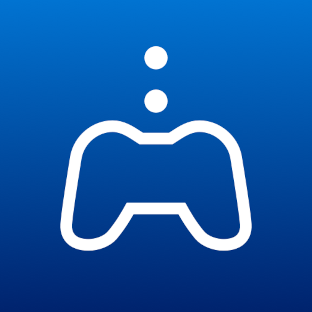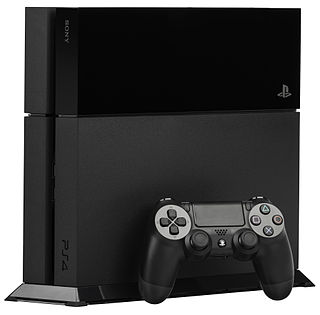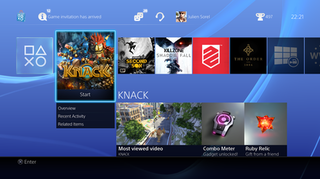
A handheld game console, or simply handheld console, is a small, portable self-contained video game console with a built-in screen, game controls and speakers. Handheld game consoles are smaller than home video game consoles and contain the console, screen, speakers, and controls in one unit, allowing players to carry them and play them at any time or place.

The PlayStation Portable (PSP) is a handheld game console developed and marketed by Sony Computer Entertainment. It was first released in Japan on December 12, 2004, in North America on March 24, 2005, and in PAL regions on September 1, 2005, and is the first handheld installment in the PlayStation line of consoles. As a seventh generation console, the PSP competed with the Nintendo DS.
The DualShock is a line of gamepads developed by Sony Interactive Entertainment for the PlayStation family of video game consoles. It is named for vibration-feedback and analog controls. It was introduced in November 1997 as a secondary peripheral for the first PlayStation console. The console's bundle was updated to include DualShock, and phase out the original PlayStation controller and the Dual Analog Controller. The DualShock is the best-selling gamepad of all time by units sold, excluding bundled controllers.
The history of video game consoles, both home and handheld, began in the 1970s. The first console that played games on a television set was the 1972 Magnavox Odyssey, first conceived by Ralph H. Baer in 1966. Handheld consoles originated from electro-mechanical games that used mechanical controls and light-emitting diodes (LED) as visual indicators. Handheld electronic games had replaced the mechanical controls with electronic and digital components, and with the introduction of Liquid-crystal display (LCD) to create video-like screens with programmable pixels, systems like the Microvision and the Game & Watch became the first handheld video game consoles.

Sony Interactive Entertainment LLC (SIE) is an American multinational video game and digital entertainment company of Sony. Jointly established by two subsidiaries in 2016, it primarily operates the PlayStation brand of video game consoles and products. It is also the world's largest company in the video game industry based on its equity investments.
Various accessories for the PlayStation 3 video game console have been produced by Sony and third-party companies. These include controllers, audio and video input devices like microphones, video cameras, and cables for better sound and picture quality.

Remote Play is a feature of Sony video game consoles that allow the PlayStation 3, PlayStation 4 and PlayStation 5 to transmit video and audio output to another device; previously this could only be a PlayStation Portable or PlayStation Vita. In 2014, it was expanded to include the use of PlayStation TV, Xperia smartphones and tablets, and PlayStation Now. In 2016, it was expanded to Microsoft Windows PCs and macOS. In 2019, support for Android and iOS devices was eventually added. Support for remote play of PlayStation 5 games to other devices was added in November 2020 just prior to the new console's launch.

The PlayStation 3 system software is the updatable firmware and operating system of the PlayStation 3. The base operating system used by Sony for the PlayStation 3 is a fork of both FreeBSD and NetBSD known internally as CellOS or GameOS. It uses XrossMediaBar as its graphical shell.
PlayStation is a video gaming brand that consists of five home video game consoles, two handhelds, a media center, and a smartphone, as well as an online service and multiple magazines. The brand is produced by Sony Interactive Entertainment, a division of Sony.

The PlayStation 2 (PS2) is a home video game console developed and marketed by Sony Computer Entertainment. It was first released in Japan on 4 March 2000, in North America on 26 October 2000, in Europe on 24 November 2000, and in Australia on 30 November 2000. It is the successor to the PlayStation (console), as well as the second installment in the PlayStation brand of consoles. As a sixth-generation console, it competed with Nintendo's GameCube, Sega's Dreamcast, and Microsoft's Xbox. It is the best-selling video game console of all time, having sold over 155 million units worldwide, nearly triple the combined sales of the Dreamcast, GameCube, and Xbox.

The PlayStation Vita is a handheld game console developed and marketed by Sony Interactive Entertainment. It was first released in Japan on December 17, 2011, and in North America, Europe, and other international territories beginning on February 22, 2012. The console is the successor to the PlayStation Portable, and a part of the PlayStation brand of gaming devices; as part of the eighth generation of video game consoles, it primarily competed with the Nintendo 3DS.
The eighth generation of video game consoles began in 2012, and consists of four home video game consoles: the Wii U released in 2012, the PlayStation 4 family in 2013, the Xbox One family in 2013, and the Nintendo Switch family in 2017.

The PlayStation 4 (PS4) is a home video game console developed by Sony Interactive Entertainment. Announced as the successor to the PlayStation 3 in February 2013, it was launched on November 15, 2013, in North America, November 29, 2013, in Europe, South America, and Australia, and on February 22, 2014, in Japan. A console of the eighth generation, it competes with Microsoft's Xbox One and Nintendo's Wii U and Switch.

The PlayStation 4 system software is the updatable firmware and operating system of the PlayStation 4. The operating system is Orbis OS, based on FreeBSD 9.

A microconsole is a home video game console that is typically powered by low-cost computing hardware, making the console lower-priced compared to other home consoles on the market. The majority of microconsoles, with a few exceptions such as the PlayStation TV and OnLive Game System, are Android-based digital media players that are bundled with gamepads and marketed as gaming devices. Such microconsoles can be connected to the television to play video games downloaded from an application store such as Google Play.
PlayStation Now was a standalone video game subscription service on consoles developed by Sony Interactive Entertainment. The service offered cloud gaming for PlayStation 2, PlayStation 3, and PlayStation 4 games that could be played on PlayStation 4, PlayStation 5 and Microsoft Windows computers. In addition, PlayStation 2, and PlayStation 4 games could be downloaded to play locally on PlayStation 4 and PlayStation 5. With the expansion of the PlayStation Plus service to offer additional tiers in May–June 2022, the standalone PlayStation Now subscription was shut down, but its services were incorporated into the PlayStation Plus Premium tier.

The PlayStation 5 (PS5) is a home video game console developed by Sony Interactive Entertainment. It was announced as the successor to the PlayStation 4 in April 2019, was launched on November 12, 2020, in Australia, Japan, New Zealand, North America, and South Korea, and was released worldwide one week later. The PS5 is part of the ninth generation of video game consoles, along with Microsoft's Xbox Series X/S consoles, which were released in the same month.














